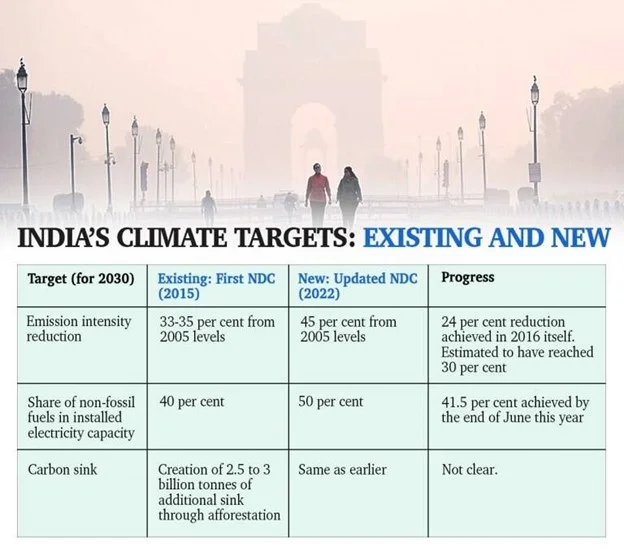Environment & Ecology
In News: As India strengthens its climate targets, a look at the progress so far.
- Nine months after Prime Minister made a few headline-grabbing promises at the climate change conference in Glasgow last year, the government, converted two of those into official targets, which would now be part of India’s international climate commitments for 2030.

- Along with the above mentioned new targets, PM also said that at least 500 GW of India’s installed electricity generation capacity in 2030 would be based on non-fossil fuel sources.
- Also, India promised that it would ensure avoided emissions of at least one billion tonnes of carbon dioxide equivalent between now and 2030.
- These two promises have not been converted into official targets.
- PM also announced a net zero target for India for the year 2070.
India’s progress
The upward revision of the two climate targets — those relating to reductions in emissions intensity and proportion of non-fossil sources in electricity generation — do not come as a surprise.
India is on way to achieve its existing targets well ahead of the 2030 timeline.
Emission
- India’s emissions intensity was 24 per cent lower than the 2005 levels in the year 2016
- It is very likely that the 33 to 35 per cent reduction target has already been achieved, or is very close to being achieved.
- A further reduction of 10-12 per cent from here, to meet the new target, does not appear too challenging
Electricity
- The other target — having at least 40 per cent of electricity coming from non-fossil fuels — has officially been reached.
- According to the latest data from the power ministry, 41.5 per cent of India’s current installed electricity capacity of 403 GW is now powered by non-fossil fuels.
- Renewables (wind, solar and others) alone account for more than 28 per cent of this capacity while hydropower contributes over 11 per cent.
- With most of the new capacity additions happening in the renewable energy sector, a 10 per cent rise in the share of non-fossil fuels in electricity generation is not an unrealistic target.
Tricky Glasgow promises
Two promises made in Glasgow have not been converted into official targets.
- India announced that India’s non-fossil fuel electricity generation capacity would touch 500 GW in 2030.
- And also India would cut at least one billion tonnes of carbon dioxide equivalent from its net projected emissions between now and 2030.
Both these promises were tricky.
The 500 GW non-fossil fuel electricity capacity target for 2030 is not easy.
- Of the current installed capacity of 403 GW, over 236 GW, or 58.5 per cent comes from fossil fuel sources, while non-fossil fuels, which include not just renewables like solar or wind but also hydropower, nuclear and others, make up only 167 GW.
- Capacity additions from non-fossil sources would have to triple in the next 10 years to reach the 500 GW target.
The promise to reduce at least one billion tonnes of carbon dioxide equivalent from the cumulative projected emissions till 2030 was even more problematic.
- It was the first time that India had enunciated any climate target in terms of absolute emission reductions.
- But it appears it was announced without much preparatory work. India does not have any official projection of its emissions in 2030.
- In the absence of a baseline, the target would have been meaningless.
Financial and technological support
- India’s enhanced climate commitments were likely to be contingent on the availability of international finance and technology from the developed countries.
- The updated NDC does talk about the need for low-cost international finance and transfer of technology, but does not make achievement of targets contingent on their availability. This was the case in the previous NDC as well.
Source: Indian Express














